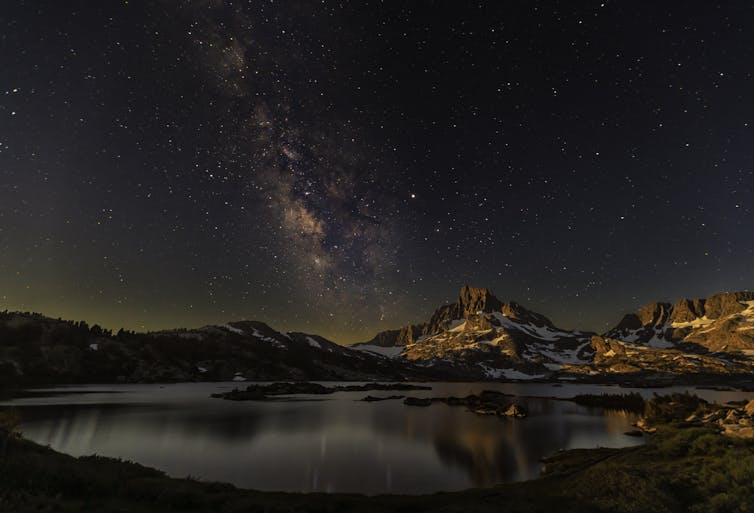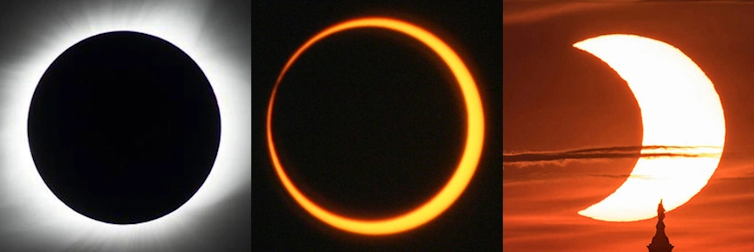Astro-tourism – chasing eclipses, meteor showers and elusive dark skies from Earth

Vahe Peroomian, USC Dornsife College of Letters, Arts and Sciences
For years, small groups of astronomy enthusiasts have traveled the globe chasing the rare solar eclipse. They have embarked on cruises to the middle of the ocean, taken flights into the eclipse’s path and even traveled to Antarctica. In August 2017, millions across the U.S. witnessed a total solar eclipse visible from Oregon to South Carolina, with a partial eclipse visible to the rest of the continental U.S.
The interest in astronomical events that this eclipse sparked will likely return with two eclipses visible in the U.S. during the next year – the annular solar eclipse on Oct. 14, 2023, and the total eclipse on April 8, 2024. But astro-tourism – traveling to national parks, observatories or other natural, dark-sky locations to view astronomical events – isn’t limited just to chasing eclipses.
According to a recent study, 80% of Americans and one-third of the planet’s population can no longer see the Milky Way from their homes because of light pollution. As a consequence, most people have to travel to witness meteor showers and other common astronomical events.
I am a space scientist with a passion for teaching physics and astronomy and photographing the night sky. Every summer I spend several nights backpacking in the Sierra Nevada mountains of California, where the skies are sufficiently dark to allow the Milky Way to be seen with the naked eye. My son and I also like to take road trips – often along U.S. 395, the Eastern Sierra Scenic Byway – that coincide with eclipses and meteor showers.

Vahe Peroomian
Can’t miss astronomical events
There are two types of eclipses. Lunar eclipses occur when the full moon passes through Earth’s shadow. Solar eclipses occur when the new moon briefly blocks the Sun.

Nela (nyabla.net)/Wikimedia Commons, CC BY-SA
There are three types of solar eclipses. During a total eclipse, the Moon completely covers the Sun, with totality, or the time during which the Sun is completely eclipsed, lasting as long as seven minutes. During totality, those in the path of the eclipse will see the Sun’s corona, or its outer atmosphere, behind the Moon’s silhouette.
The Moon’s orbit around the Earth is an ellipse, so the Moon can appear to be 15% smaller when it’s at its farthest point from Earth, its apogee, compared with its size when it is at its closest point to Earth, its perigee. An annular eclipse occurs when the Moon doesn’t cover the entire disk of the Sun, leaving a ring of sunlight around the Moon.
Finally, a partial eclipse occurs when the Moon blocks only a part of the Sun’s disk, as the name implies.

Credits: Total eclipse, left: NASA/MSFC/Joseph Matus; annular eclipse, center: NASA/Bill Dunford; partial eclipse, right: NASA/Bill Ingalls, CC BY-NC
Meteor showers are a far more common astronomical event than eclipses, and they are visible from any dark-sky location on Earth. Meteor showers occur when Earth’s orbit around the Sun takes it through the dust left behind by a comet. The Earth sweeps up the dust like a car speeding through a cloud of insects on the highway.
Meteor showers are named for the constellations from which the meteors seem to emanate, though it’s not necessary to stare in that direction to see meteors. The most prominent meteor showers, occurring on approximately the same dates every year, are the Perseids, named for the constellation Perseus and peaking on the night of Aug. 12-13; the Geminids, named for the constellation Gemini, on Dec. 14-15; and the Lyrids, named for the constellation Lyra, on April 21-22. The night sky will be mostly moonless for the first two this year, but a nearly full moon will make the Lyrid shower of 2024 difficult to see.

Tips for aspiring astro-tourists
One of the most important factors to consider when planning an outing to stargaze or to watch a meteor shower is the phase of the Moon. The full moon rises at about 6 p.m. and sets at 6 a.m., making stargazing all but impossible because of its brightness. For ideal stargazing conditions, the Moon should be below the horizon, and the best viewing conditions are during new moon. You can use a moonrise/moonset calculator to determine the phase of the Moon and its rise and set times for any location on Earth.
Another important factor is weather. Amateur astronomers always joke that the sky is cloudy during the most interesting astronomical events. For example, most major cities in the U.S. that are in the path of the April 2024 eclipse have had cloudy skies on April 8 60% of the time since the year 2000.
Most Americans live in heavily light-polluted areas. A light pollution map such as lightpollutionmap.info can help identify the nearest dark-sky location, which, in my case, is hours away. These maps often use the Bortle dark-sky scale, which reports 1 for extremely dark skies to 9 for highly light-polluted city centers.
Though you may still see the brightest meteors from city suburbs, the darker your sky, the more meteors you’ll see. In general, expect to see fewer than 25 meteors per hour. To see the complex structure of the Milky Way with the naked eye, look for a location with a Bortle index of 3 or below.
It’s important to arrive at your chosen site early, preferably during daylight hours. Stumbling around in the dark at an unfamiliar site is a recipe for disaster and may also disturb others who are already at the site. Arriving early also gives time for your eyes to adapt to the dark as night falls, as it typically takes 30 minutes or even longer for your eyes to reach their full dark-adapted potential.
Make sure to carry a headlamp or flashlight that has a red light setting, as red light doesn’t ruin night vision. Avoid using your phone, as even a glance at the screen can ruin your eyes’ dark adaptation. If you’re using a sky-viewing app, switch the app to night mode.
Plan ahead if you’re thinking of traveling to view one of the eclipses visible in the U.S. next year. If you’re in the path of the eclipse, stay put! If you’re traveling, staying at the same location overnight before and after the eclipse can help avoid the hourslong traffic jams experienced by eclipse watchers in 2017.

Also, you should never look at the Sun directly with the naked eye, even during a total eclipse. You’ll need a pair of inexpensive eclipse glasses to watch and fully enjoy the eclipse, but get yours early, as many stores ran out of glasses during the 2017 eclipse.
No matter where you travel during the next year, don’t forget to look up at night and marvel at the beauty of the night sky away from city lights.
Vahe Peroomian, Professor of Physics and Astronomy, USC Dornsife College of Letters, Arts and Sciences
This article is republished from The Conversation under a Creative Commons license. Read the original article.















